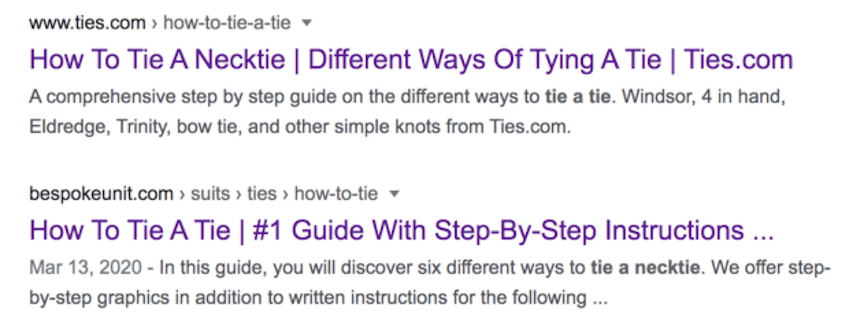-
 8 min. read
8 min. read
-
 Sarah Berry
Sarah Berry Lead Web Marketing Consultant
Lead Web Marketing Consultant
- Sarah Berry is a Lead Web Marketing Consultant at WebFX. With more than 10,000 hours of experience, she offers practical insights and strategies you can use to grow your digital revenue. When she isn’t polishing her Time Magazine Person of the Year Award, she’s spending time with her flock of ducks.
Ranking well in search engine results is incredibly important for increasing traffic to your site. But did you know that even once you rank, there’s more you can do to get people to click through to your page? In fact, one tactic, in particular, can convince people to choose your page over others ranked higher than yours — and it doesn’t take more than 155 characters.
What is this magical tactic, you ask? Writing a compelling meta description. In this guide, we’ll show you how to write meta descriptions that win clicks and give you helpful meta description examples for blogs and websites.
Keep reading to learn how to write a winning meta description. Or, contact our team of digital marketing experts for help with your meta descriptions and overall digital marketing strategy.
What exactly is a meta description?
First thing’s first, what is a meta description? A meta description is an HTML attribute of a web page that provides a brief description of the content on the page.
Search engines often show a page’s meta description in search results, so if you’ve ever used a search engine, you’ve probably seen plenty of meta descriptions. You’ll probably be able to recognize the meta description in this example:  As far as coding, you’ll want to add your meta description tags to the <head> section of your page. Below is the meta description that we used on our B2B web applications page.
As far as coding, you’ll want to add your meta description tags to the <head> section of your page. Below is the meta description that we used on our B2B web applications page.
 If you’re writing a meta description on WordPress and using the Yoast SEO tool, you can write it in the Yoast SEO snippet editor and see a preview of how it looks in Google.
If you’re writing a meta description on WordPress and using the Yoast SEO tool, you can write it in the Yoast SEO snippet editor and see a preview of how it looks in Google.  If you write a meta description, Google may show it on search results pages or even use it as a featured snippet. Don’t get too attached to your meta description, though.
If you write a meta description, Google may show it on search results pages or even use it as a featured snippet. Don’t get too attached to your meta description, though.
Google might pull an excerpt from your page if it thinks that provides a better description, and not use the meta that you created at all.
Why your meta description matters
So, why should you care about creating a compelling meta description? Your meta description can help convince users to click through to your page and choose your site over others that appear in search results.
You can think of your meta description as a short advertisement for your content that tells users what your page is about and why they should visit it. Google doesn’t use meta descriptions as a ranking factor, meaning your metas don’t play a direct role in how pages rank.
Google does, however, consider user behavior. When users select your page, Google interprets this as them finding your web page valuable. The more people choose your page, the more valuable Google believes your page is, and the higher it will rank it in search results.
So, by convincing users to click through to your page, your meta descriptions can influence your rankings indirectly and boost your overall SEO.
How to write an enticing, click-worthy meta description
So, how can you write meta descriptions that get people to click through to your page? Check out the following tips on how to write meta descriptions.
1. Focus on usability
Your meta descriptions are for users, so try to make them as useful as possible. Provide an accurate, easy-to-read description so readers know what to expect when they go to your page. Accuracy is important because if users don’t get what they expect, they’ll click away, leading to a high bounce rate.
This will tell Google that users didn’t find what they needed on your site, and could affect your ranking negatively.
2. Make it unique
Make sure that you create a unique meta description for each page on your site. Copying a description across multiple pages reduces the description’s usefulness. A generic meta description doesn’t tell users much about the page’s content and suggests that the content on each page is more or less the same.
You also want your description to stand out from those of the other search results.
A unique description will get users’ attention and may encourage them to choose your page over other search results.
3. Inspire action
Your meta descriptions should get people’s attention and inspire them to take action. Use an active voice and include a call to action in your description. This meta description example contains two CTAs — one to explore the site’s ranking of the best colleges and one to compare the top colleges.
It also provides a concise, accurate description of the page’s content. 
4. Include keywords
Another important tip on how to write meta descriptions is to include the target keywords for your page in your meta description. Doing so might make Google more likely to show your description.
Google and other search engines also bold keywords that appear in meta descriptions, which can get readers’ attention. Here’s one of the top results for the keyword phrase, “how to change a bike tire.” You can see that Google bolded this phrase in the meta description.  The bold text will draw users’ eyes and lets them know the page will give them the information they’re looking for — how to change a bike tire.
The bold text will draw users’ eyes and lets them know the page will give them the information they’re looking for — how to change a bike tire.
5. Keep it under 155 characters
Google typically truncates meta descriptions after about 155 characters, so keep them to that length or at least include the essential information before surpassing 155 characters. Aim to make your descriptions sufficiently descriptive without being unnecessarily wordy or going over the recommended character count.
Here is our Google Preview Tool to help you not just count characters in your descriptions — it lets you visualize how your site pages will be displayed on search engines.
6. Consider using structured data
Also, consider using schema markup to add elements to your descriptions. For example, you can add ratings, product information, or FAQs to make your snippets more engaging and descriptive.
Meta description examples
Looking at examples can be helpful when trying to write a compelling meta description. Here are a few meta description examples for blogs and websites to help you craft the perfect description.
In this meta description for the Washington Post’s page for news about soccer, the Washington Post provides a description that succinctly describes the page’s contents. It also includes a call to action and keywords related to soccer.  Below are a couple of the top results for the search, “how to tie a tie.” In the first example, Google used the site’s intended meta description.
Below are a couple of the top results for the search, “how to tie a tie.” In the first example, Google used the site’s intended meta description.
In the second one, Google pulled a snippet from the article. While the snippet accurately describes the content of the article, Google cut off the last part of the second sentence.  Below is a meta description for a page that features a recipe for chicken soup.
Below is a meta description for a page that features a recipe for chicken soup.
This meta description example has some additional features, including the date it was published, a rating for the recipe, how many people rated the recipe, how long it takes to cook, and how many calories a serving contains. 
WebFX: Digital marketing that drives results
At WebFX, our more than 29 years of experience and our team of more than 500 digital marketing experts have helped us generate nearly $10 billion in revenue for our clients over the last five years. To learn more about meta descriptions, SEO, and other digital marketing topics, explore our free resources.
Or, contact us to speak with a strategist today.
-
 Sarah Berry is a Lead Web Marketing Consultant at WebFX. With more than 10,000 hours of experience, she offers practical insights and strategies you can use to grow your digital revenue. When she isn’t polishing her Time Magazine Person of the Year Award, she’s spending time with her flock of ducks.
Sarah Berry is a Lead Web Marketing Consultant at WebFX. With more than 10,000 hours of experience, she offers practical insights and strategies you can use to grow your digital revenue. When she isn’t polishing her Time Magazine Person of the Year Award, she’s spending time with her flock of ducks. -

WebFX is a full-service marketing agency with 1,100+ client reviews and a 4.9-star rating on Clutch! Find out how our expert team and revenue-accelerating tech can drive results for you! Learn more
Try our free Marketing Calculator
Craft a tailored online marketing strategy! Utilize our free Internet marketing calculator for a custom plan based on your location, reach, timeframe, and budget.
Plan Your Marketing Budget

SEO Success with KOA

Proven Marketing Strategies
Try our free Marketing Calculator
Craft a tailored online marketing strategy! Utilize our free Internet marketing calculator for a custom plan based on your location, reach, timeframe, and budget.
Plan Your Marketing Budget
What to read next




